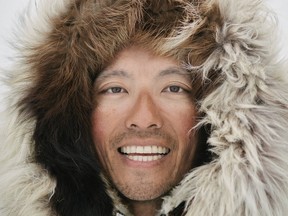
Reviews and recommendations are unbiased and products are independently selected. Postmedia may earn an affiliate commission from purchases made through links on this page.
Article content
When Kiliii Yuyan first visited the north as a photographer 10 years ago for National Geographic, he had no intention of being a fly-on-the-wall chronicler of Arctic life.
He was invited by the wife of a whaling captain to Utqiagvik, the largest city of the North Slope Borough in Alaska and the home of the Inupiaq. Eventually, he joined them on a whaling expedition and was determined to make himself useful.
Advertisement 2
Article content
Article content
“They could see very quickly I wasn’t going to be a person who was just going to stand around and eat all their food and be cold and whine,” says Yuyan, in an interview with Postmedia. “The first thing I did when I got there was start playing with the kids. They were out there butchering seals and I started helping them butcher seals and just do stuff. My parents certainly didn’t raise me to stand around while everyone else was working. I learned very quickly the things that I didn’t know and I was always helpful.”
It was more than just his work ethic that compelled Yuyan to help. He has earned a reputation for capturing stories from the Arctic, some of which will be presented on Sunday and Monday at the Jack Singer Concert Hall as part of Kiliii Yuyan: Life on Thin Ice. Being a participant, and not just a fly-on-the-wall chronicler, has deepened his connection to both the land and the people.
“Participating in it makes you really understand it, not from your mind but from your heart,” he says. “It’s such a revelation when you are able to work on a story that comes from the heart.”
From the National Geographic Live series, Life on Thin Ice will offer a multi-media voyage to the Arctic Circle and offer Yuyan’s images of the Indigenous people who live there — 40 different ethnic groups live in the north — and the polar bears, musk ox, whales and caribou they interact with. It takes viewers from Alaska to northern Greenland.
Article content
Advertisement 3
Article content
“The show is really about the sights, the sounds and smells of the Arctic,” he says. “It’s quite multi-disciplinary in the sense that we’re going to listen to the bearded seals underwater and trudge around with musk ox. A lot of people tell me afterwards that they felt like they were in those 30-knot winds when I play the video and hang out with the musk ox and things like that.”
Yuyan was born in the United States but spent much of his early childhood with his Nanai grandmother in northern Manchuria, which is the Chinese portion of Siberia. By the age of seven, he was living in the United States but never felt like he belonged. Before becoming a photographer, he built and paddled traditional kayaks and immersed himself in the culture and practises of his Nanai ancestors. Working for National Geographic, he has travelled the world documenting modern Indigenous communities and wildlife.
“It’s come full circle for me,” he says. “My grandmother raised me so she inculcated in me a lot of our values and a lot of our stories and cosmology, the way that we see the world. So I grew up with all these really cool stories about the world. But then I eventually moved to the United States and was living in this weird secular, individualistic world. Looking back as I got older to my teenage years, I realized how much I didn’t fit in and how much I felt like I didn’t get a chance to live in my community and the beautiful Siberian land full of killer whales and sables and snow and all of that. When I started going up into the Arctic to do work with kayaks and photography … I felt so comfortable there and that I belonged. Even cooler than that, it felt like I was living inside of the stories that my grandmother told me when I was a kid.”
Advertisement 4
Article content

The tagline for his work is often something like “capturing human experience in some of the world’s harshest environments.” But the relationship these Indigenous communities have with their land is far more complicated than a fight for survival. There are challenges — climate change, for instance, is altering their way of life — but these Indigenous communities are not defined by struggle.
“To think of the Arctic as a barren, desolate place where people are just scraping by is to underestimate human beings in general,” he says. “As humans, we’re really, really good and once we’ve lived in a place for a couple of generations we get to really know that place and we’re not just scraping by, we’re thriving. That definitely how it is in the Arctic, people are thriving and doing really well.”
Yuyan makes several trips a year to the Arctic. He was back in Utqiagvik earlier this year, as he does every year. He considers the hunting crew part of his extended family.
“Now, I’m one of the core members of that hunting crew and I reliably show up every year during the spring season,” he says. “I’m always there and now I’ve become a core part of this thing that keeps everybody together and that’s quite an honour. It’s quite a feeling. It feels like a big communal hug.”
Kiliii Yuyan: Life on Thin Ice will be at the Arts Commons Jack Singer Concert Hall on May 26 at 3 p.m. and May 27 at 7 p.m.
Article content


